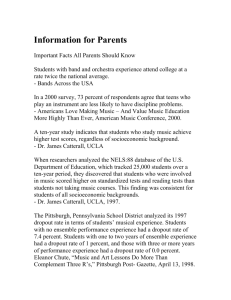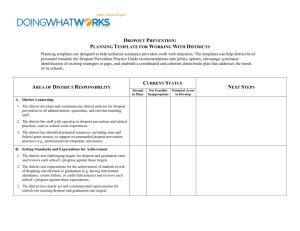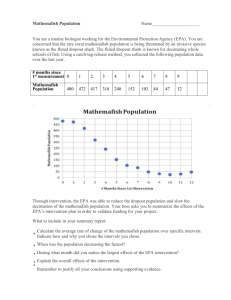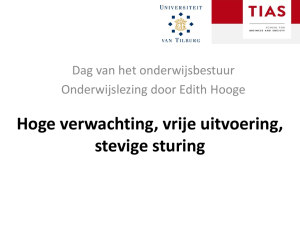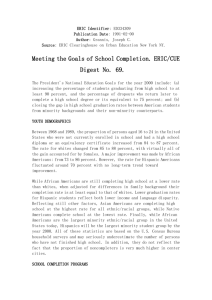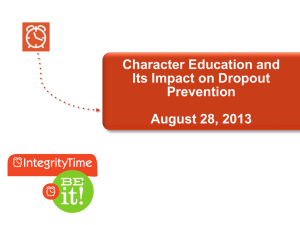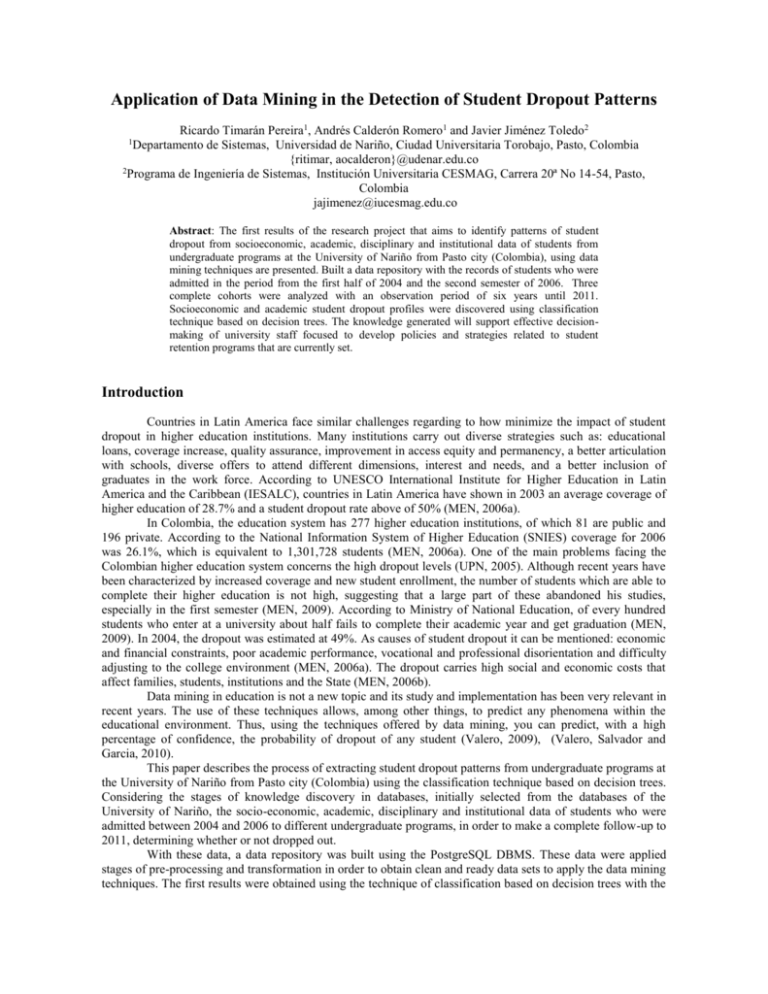
Application of Data Mining in the Detection of Student Dropout Patterns
Ricardo Timarán Pereira1, Andrés Calderón Romero1 and Javier Jiménez Toledo2
Departamento de Sistemas, Universidad de Nariño, Ciudad Universitaria Torobajo, Pasto, Colombia
{ritimar, aocalderon}@udenar.edu.co
2
Programa de Ingeniería de Sistemas, Institución Universitaria CESMAG, Carrera 20ª No 14-54, Pasto,
Colombia
jajimenez@iucesmag.edu.co
1
Abstract: The first results of the research project that aims to identify patterns of student
dropout from socioeconomic, academic, disciplinary and institutional data of students from
undergraduate programs at the University of Nariño from Pasto city (Colombia), using data
mining techniques are presented. Built a data repository with the records of students who were
admitted in the period from the first half of 2004 and the second semester of 2006. Three
complete cohorts were analyzed with an observation period of six years until 2011.
Socioeconomic and academic student dropout profiles were discovered using classification
technique based on decision trees. The knowledge generated will support effective decisionmaking of university staff focused to develop policies and strategies related to student
retention programs that are currently set.
Introduction
Countries in Latin America face similar challenges regarding to how minimize the impact of student
dropout in higher education institutions. Many institutions carry out diverse strategies such as: educational
loans, coverage increase, quality assurance, improvement in access equity and permanency, a better articulation
with schools, diverse offers to attend different dimensions, interest and needs, and a better inclusion of
graduates in the work force. According to UNESCO International Institute for Higher Education in Latin
America and the Caribbean (IESALC), countries in Latin America have shown in 2003 an average coverage of
higher education of 28.7% and a student dropout rate above of 50% (MEN, 2006a).
In Colombia, the education system has 277 higher education institutions, of which 81 are public and
196 private. According to the National Information System of Higher Education (SNIES) coverage for 2006
was 26.1%, which is equivalent to 1,301,728 students (MEN, 2006a). One of the main problems facing the
Colombian higher education system concerns the high dropout levels (UPN, 2005). Although recent years have
been characterized by increased coverage and new student enrollment, the number of students which are able to
complete their higher education is not high, suggesting that a large part of these abandoned his studies,
especially in the first semester (MEN, 2009). According to Ministry of National Education, of every hundred
students who enter at a university about half fails to complete their academic year and get graduation (MEN,
2009). In 2004, the dropout was estimated at 49%. As causes of student dropout it can be mentioned: economic
and financial constraints, poor academic performance, vocational and professional disorientation and difficulty
adjusting to the college environment (MEN, 2006a). The dropout carries high social and economic costs that
affect families, students, institutions and the State (MEN, 2006b).
Data mining in education is not a new topic and its study and implementation has been very relevant in
recent years. The use of these techniques allows, among other things, to predict any phenomena within the
educational environment. Thus, using the techniques offered by data mining, you can predict, with a high
percentage of confidence, the probability of dropout of any student (Valero, 2009), (Valero, Salvador and
Garcia, 2010).
This paper describes the process of extracting student dropout patterns from undergraduate programs at
the University of Nariño from Pasto city (Colombia) using the classification technique based on decision trees.
Considering the stages of knowledge discovery in databases, initially selected from the databases of the
University of Nariño, the socio-economic, academic, disciplinary and institutional data of students who were
admitted between 2004 and 2006 to different undergraduate programs, in order to make a complete follow-up to
2011, determining whether or not dropped out.
With these data, a data repository was built using the PostgreSQL DBMS. These data were applied
stages of pre-processing and transformation in order to obtain clean and ready data sets to apply the data mining
techniques. The first results were obtained using the technique of classification based on decision trees with the
free data mining tool named Weka. Finally, these results were analyzed, evaluated and interpreted to determine
the validity of the obtained knowledge. The knowledge generated will support effective decision-making of
university staff focused to develop policies and strategies related to student retention programs that are currently
set.
The remain of the paper is organized as follows: In Section 2 related works are presented. In Section
3, the methodology applied in this research is explained in detail. Afterwards, Section 4 discusses the obtained
results and, finally, section 5 shows the conclusions and future works.
Related Works
In Latin America, several research projects using data mining to discover patterns of dropout have
been developed. At the National University of Misiones (Argentina) conducted research on student dropout
using data mining techniques. Its main objective was to maximize the quality of the models to classify and
group students according to their academic characteristics and their social and demographic factors. The study
focused at students of the Analyst in Computer Systems Program at the Faculty of Natural Sciences. This
research analyzed data from the cohorts from 2000 to 2006 (Pautsch, 2009), (Pautsch, La Red and Cutro, 2010).
Similarly, at the National University of the Northeast (Argentina), a study was carried out with the
main goal of applying data warehousing and data mining techniques, mainly based on clustering, in order to
find dropout profiles. The techniques were applied to students of the Operating Systems Course of the
Information Systems Program. As results, students were classified by their academic performance and their
demographic and socioeconomic status, allowing a priori knowledge of potential scenarios for academic success
or failure (La Red et al., 2010).
At the National University of Matanza (Argentina) were applied data mining techniques to evaluate
academic performance and dropout of students from the Department of Engineering and Technological
Research on data since 2003 to 2008. The implementation of this process was performed using MS SQL Server
software to generate a data warehouse, SPSS software for data preprocessing and Weka (Waikato Environment
for Knowledge Analysis) to find a classifier for academic performance to detect patterns of education dropout
(Spositto et al., 2010).
At Izúcar Technological University of Matamoros (Mexico), proposed a research to identify the causes
for the desertion of its students. Using the technique of classification and Weka as data mining tool, they found
relationships between academic attributes that identify and predict the chance of dropout. Additionally, they
proposed a tool that allows the tutor to predict the probability of dropping out of any student at any time during
your stay at University (Valero, 2009), (Valero, Salvador and Garcia, 2010).
At the University of Sabana, in Colombia, conducted a research project where the goal was to select,
from a database of students, attributes that have the greatest impact on the dropout of the university in the past
four years. The study used classification by rough sets as data mining technique using the Rose2 software
package (Restrepo and Lopez, 2008).
Pinzon (2011) presents the characterization of student profile defector from the School of Marketing
and Advertising at the Sergio Arboleda University (Colombia). The author applied clustering, using the Kmeans algorithm, as data mining technique. During the study, it was analyzed demographic variables obtained
in the last student enrollment record and the causes that generated the withdrawal. The end result is three types
of clusters or groups of students. For the case of the research, they were significant profiles.
Student dropout patterns discovery process
Knowledge Discovery in Databases (KDD) is the extraction of implicit, previously unknown, and
potentially useful information from data (Witten and Frank, 2000). KDD is basically an automatic process that
combines discovery and analysis. The KDD process is interactive and iterative, involving numerous steps with
many decisions made by user. This process usually involves preprocessing the data, make data mining and
visualize the results (Agrawal and Srikant, 1994), (Chen, Han, and Yu, 1996), (Piatetsky-Shapiro, Brachman
and Khabaza, 1996), (Han and Kamber, 2001).
In the process of discovering student dropout patterns in undergraduate programs, the following steps
were performed:
Selection Step
The main goal of this step is selecting a data set from internal or external sources of data, or focusing
on a subset of variables or data samples, on which discovery is to be performed. Internal sources were selected
from the Grades and Register-UDENAR databases from the Admissions and Academic Control Office
(OCARA) of the University of Nariño. Given the observation window for this study (2004-2011), these
databases store personal and academic information of 14,974 students (OCARA, 2011). As main external
sources of data were selected diverse databases from different Colombian Institutions such as: the Colombian
Institute for the Development of Higher Education (ICFES), the National Bureau of Statistics (DANE), the
Dropout Prevention in Higher Education System (SPADIES), the Potential Beneficiaries of Social Programs
Information System (SISBEN) and the Colombian National Registry of Civil Status (all acronyms come from
their names in Spanish).
From 14,974 records previously selected only data of students of cohorts 2004, 2005 and 2006 with the
attributes most relevant to this study were chosen. The outcome is 6524 records and 62 attributes belonging to
socio-economic, academic, and institutional data. These data were stored in a table named T6524A62 in a
database called UDENAR_REPOSITORY using PostgreSQL. This table will be the basis for subsequent phases
of the dropout patterns discovery process.
Preprocessing Step
The goal at this stage is to obtain clean data, i.e. data without null or outlier values, in order to retrieve
high quality patterns. Through ad-hoc queries or histograms on the T6524A62 table, the quality of the data
available for each of its attributes was thoroughly analyzed.
Considering the relevance of certain attributes for this research, null values of these attributes were
updated with the values found in external sources. However, the attributes with a high percentage of nulls data
(more than 80%), were eliminated by the inability to obtain these values from external sources, using statistical
techniques such as mean, median and mode or deriving their values through others.
As result of this stage and in order to generate knowledge about the socioeconomic, academic,
disciplinary and institutional factors, the 31 most representative attributes were selected from T6524A62 table.
A new table was created and called as T6524A31. From these 31 attributes, 18 were chosen to analyse the
socioeconomic factor and 15 for the academic factor. Similarly, two new tables (T6524A18 and T6524A15)
were created respectively. A detail description of these new tables is shown in [Table 1]. Given the small
number of selected attributes for disciplinary and institutional factors, these were added in the academic one.
TABLE
DESCRIPTION
T6524A31
Table containing 6524 students
admitted in 2004-2006 and with 31
attributes to be considered in the
study.
Table of 6524 students and 18
attributes to consider social and
economic factors.
Table of 6524 students and 15
attributes to consider for academic
factors.
T6524A18
T6524A15
Table 1: New tables of UDENAR-REPOSITORY database
Transformation Step
Data transformation includes any process that modifies the form of the data. The aim of this stage is to
transform the data source in a dataset ready to apply any of the different techniques of data mining. Among the
operations performed to transform the data are: elimination of the least relevant attributes, creation of new
attributes by deriving them from others (keeping or replacing these attributes) and / or modification of the type
of attributes (using discretization or continuity methods).
In order to facilitate patterns extraction, the numerical values of attributes in table T6524A31 were
translated to nominal values. This process (known as discretization) was carried out using the discretize filter in
Weka with the equal frequency parameter (useEqualFrequency) set to 6 values. Moreover, the T6524A31 table
was adapted to ARFF format (Attribute Relation File Format) required by Weka to continue with the data
mining phase. [Table 2] shows the attributes of the table T6524A31 with the new discretized values. According
to this table, the first 17th attributes together with the attribute 31th, form the T6524A18 table and correspond to
the socioeconomic attributes. Similarly, the attributes from 17th to 31st correspond to the academic attributes
and conform the T6524A15 table.
No
ATTRIBUTES AND VALUES
1
2
gender {male,female}
marital_status {single,married,divorcée,civil union,single
mother,widower,religious}
place_of_birth
{pasto,north,south,west,center,cost,putumayo,other}
place_of_provenance
{pasto,north,south,west,center,cost,putumayo,other}
health_regimen {contributory, subsidized}
economic_status {0,1,2,3,4,5,6,99}
father_alive {true,false}
father_occupation { various, operational, art, industry,
building, professional, ...}
mother_alive {true,false}
mother_occupation { various, operational, art, industry,
building, professional, ...}
residence_type {leased, owner,mortgage, ...}
live_with_family{true, false}
siblings_at_university {true, false}
family_income{'from 4540000 to 5980000','greater than
8540000','from 2850000 to 4540000','from 5980000 to
8854000','less than 2850000'} *figures in COP.
school_tuition_fee {'from 76639 to 106100','from 60248
to 76639','greater than 106100','less than 21550','from
21550 to 44369','from 44369 to 60247'} *figures in COP.
college_ tuition_fee {'less than 100259','from 120574 to
158846','from 100259 to 120574','from 234266 to
381504','from 158846 to 234266','greater than 381504'}
*figures in COP.
age_at_enrollment {'18','less than 18','greater than
22','from 21 to 22','19','20'}
school_type {public,private}
school_day-part {morning,afternoon,full,night,weekend}
icfes_weighted{'from 52 to 54','from 50 to 52','from 54 to
58','from 46 to 50','greater than 58','less than 46'}
icfes_average{'from 53 to 56','from 48 to 50','from 46 to
48','from 50 to 53','less than 46','greater than 56'}
icfes_total {'greater than 475','from 420 to 450','from 450
to 475','from 400 to 420','from 375 to 400','less than 375'}
campus
{Pasto,Tumaco,Tuquerres,Ipiales,Samaniego,Buesaco,'La
3
4
5
6
7
8
9
10
11
12
13
14
15
16
17
18
19
20
21
22
23
24
25
26
27
28
29
30
31
Union',Ricaurte}
faculty {'natural sciences','humanities','agricultural
sciences','economic sciences','health
sciences',engineering, ...}
area_program {mathematics,'social sciences',agronomy,
economy, accounting, arts, education}
grade_average {'from 2.4 to 3.1','from 3.5 to 3.7','greater
than 4.0','from 3.7 to 4.0','from 3.1 to 3.5','less than 2.4'}
failed_courses {'from 3 to 4','greater than 9','from 5 to
6',none,'from 1 to 2','from 7 to 9'}
failed_semester {initial semesters, middle semesters,
final semesters, not applicable, elective course}
area_course {pedagogy,philosophy,history,basic
sciences, statistics, ...}
failed_times {'2','3',none,'1','4','greater than 4'}
dropout {true, false}
Table 2: Attributes T6524A31
Data Mining Step
The goal of the data mining step is the search and discovery for unexpected and interesting patterns
from data. In this process, intelligent task are applied such as classification (Quinlan, 1986), (Wang, Iyer and
Scott, 1998), (Witten and Frank, 2000), clustering (Ng and Han, 1994), (Zhang, Ramakrishnan and Livny,
1996), sequential patterns (Agrawal and Srikant, 1995), associations (Agrawal and Srikant, 1994), (Srikant
and Agrawal, 1996) among others.
The data mining task chosen for the process of discovering student dropout patterns was classification
using a decision trees technique.
Data classification provides results from a supervised learning process. Data classification is a two-step
process. In the first step, a model is built describing a predetermined set of data classes. The input data, also
called the training set, consists of multiple examples (records), each having multiple attributes or features and
tagged with a special class label. In the second step, the model is used to classify future test data for which the
class labels are unknow (Han and Kamber, 2001), (Agrawal, Ghosh, Imielinski, Iyer and Swami, 1992).
Decision tree classification is the most popular model, because it is simple and easy to understand
(Han and Kamber, 2001), (Sattler and Dunemann, 2001), (Timaran and Millan, 2006). A decision tree is a
flow-chart-like tree structure, where each internal node denotes a test on an attribute, each branch represents an
outcome of the test, and leaf nodes represent classes. The top-most node in a tree is the root node (Han and
Kamber, 2001).
A decision tree classifier is built in two phases: a growth phase and a pruning phase. In the growth
phase, the tree is built by recursively partitioning the data until all members belong to the same class. In the
pruning phase, many branches are removed with the goal of improving classification accuracy on data (Wang,
Iyer and Scott, 1998).
The classification rules were obtained with the Weka data mining tool (Waikato Environment for
Knowledge Analysis), using the J48 algorithm, which implements the algorithm C.45 (Quinlan, 1993), and
utilizing data repositories described in Table 1.
The J48 algorithm is based on the use of the gain ratio criterion. Consequently, those variables with
greater number of different values do not have benefit in the selection. Furthermore, the algorithm incorporates
a classification tree pruning once it has been induced (Hernandez and Lorente, 2009).
T6524A31 repository was used to discover general patterns that affect the student dropout. The
dropout attribute was chosen as the class. Similarly, the datasets T6524A15 and T6524A18 were used to
determine, respectively, socioeconomic and academic factors that influence student dropout.
Evaluation Step
The objective of this final stage is the interpretation of the obtained results in order to consolidate the
discovered knowledge with two goals in mind. First, to integrate it into. other systems for further action, and
second, to compare it with previously discovered knowledge.
The most relevant classification rules are shown in the following section
Results and discussion
As a result of interpreting the decision tree generated by the algorithm J48 with data from T6524A31,
the most representative classification rules are shown in Table 3. All of them have a confidence threshold
greater than 80%.
According to the rules of [Table 3], the predominant factors in the student dropout from the University
of Nariño are academics, specially a low average in grades and the number of courses lost in the initial
semesters of the program.
Classification rules
Dropout class
Support
Confidence
grade_average = from 2.4 to 3.1 & failed_semester =
Initial semesters
True
0.1559
0.939
grade_average = from 3.7 to 4.0 & failed_times = 1
False
0.1551
0.8528
grade_average = less than 2.4
grade_average = from 3.5 to 3.7 & campus = PASTO
& failed_courses = from 7 to 9
grade_average = from 3.1 to 3.5 & failed_courses =
from 3 to 4
grade_average = from 3.5 to 3.7 & failed_courses = De
1 to 2 & failed_semester = Initial semesters
grade_average = from 3.1 to 3.5 & failed_courses = De
5 to 6 & failed_semester = Initial semesters
grade_average = from 3.5 to 3.7 & campus = PASTO
& failed_courses = from 1 to 2 & failed_semester =
Initial semesters & place_of_provenance = PASTO
True
0.1519
0.998
False
0.0314
0.8585
True
0.0264
0.9535
True
0.0227
0.8108
True
0.017
0.8198
True
0.0129
0.8341
Table 3: Most representative classification rules from T6524A31 dataset.
In order to determine the socioeconomic factors affecting student dropout, a number of classification
rules, with confidence greater than 80%, were generated using the T6524A18 dataset. The results show that the
most significant socioeconomic factors affecting student dropout are a tuition fee greater than COP$ 381,504
(around USD$ 212) and a provenance from the south of the department of Nariño (Colombia). The fact of being
single, living with mother and be in the city of Pasto may also impact education dropout.
To determine other factors associated with academic dropout, classification rules were generated with
T6524A15 dataset with a confidence greater than 80%, without the attribute grade_average. The results shown
the factors that influence academic dropout, in addition to a low average of grades and the courses lost in initial
semesters, are: the faculty to which the student belongs, specifically the faculties of Natural Sciences, Health
Sciences, Education and Arts; Also, the area of the course which was lost, such as the area of mathematical
foundations, introduction to natural science, basic training, pedagogy, economics and accounting; and the
campus of the University, particularly those located at Ipiales and Tumaco cities.
Conclusions and future works
Initial results obtained through the decision tree classification technique indicates that it is able to
generate models consistent with observed reality and theoretical support, based only on the data that is stored in
the database, for the study case of the University of Nariño. One of the great difficulties faced in these kinds of
studies is the poor data quality. Often, when the cleaning process was ended, many variables become useless by
the inability to obtain their correct values. Unfortunately, it has a direct influence on the results of data mining.
A set of general patterns for student dropout has been obtained. It is mainly determined by factors
such as a low average in grades and the number of courses students have failed at initial semesters. In addition,
socioeconomic and academic factors related with student dropout have been identified as well. The assessment,
analysis and utility of these patterns will support effective decision-making of university staff focused to
develop policies and strategies related to student retention programs that are currently set.
As future works it can be mentioned additional studies of student dropout at the University of Nariño
using other data mining techniques such as clustering and association rules in order to determine affinities,
similarities and relationships between socioeconomic and academics factors of students who drop out.
Applying the same methodology for student dropout at CESMAG University Institution and analyze
and evaluate the patterns found in both higher education institutions.
Acknowledgements
This research is funded by the Ministry of Education in Colombia and counterpart funds from the
University of Nariño and CESMAG University Institution.
References
Adamo, J.M. (2001). Data Mining for Association Rules and Sequential Patterns: Sequential and Parallel
Algorithms. New York (USA): Springer-Verlag. 253 p. ISBN: 0-387-95048-6.
Agrawal, R. & Srikant, R. (1994). Fast Algorithms for Mining Association Rules. In: 20th International
Conference on Very Large Data Bases, VLDB 1994, (12-15/09/1994). Santiago de Chile (Chile):
VLDB.Proceedings. p. 487-499. ISBN: 1-55860-153-8.
Chen, M., Han, J. & Yu, P. (1996). Data mining: An overview from database perspective. In: IEEE
Transactions on Knowledge and Data Engineering. Vol. 8, No. 6 (dic). Los Alamitos (CA, USA): IEEE
Computer Society. p. 866-883. ISSN: 1041-4347.
Fayyad, U, Piatetsky Shapiro, G. & Smyth, P. (1996). The KDD process for extracting useful knowledge from
volumes of data. In:
Comunications of the ACM. Vol 39, No. 11 (nov). New York (USA):ACM
Digital Library. p 27-34. ISSN: 0001-0782.
Garcia Morate, D. (s.f.). Manual de Weka [on líne]. <http://www.metaemotion.com/diego.garcia.morate/down
load/weka.pdf> . [consulta: 15/06/ 2012].
Han, J & Kamber, M. (2001). Data Mining: Concepts and Techniques. San Francisco (CA, USA): Morgan
Kaufmann Publishers, Academic Press. 550 p. ISBN: 1-55860-489-8.
Hernández, O.J., Ramírez, Q.M. & Ferri, R.C. (2005). Introducción a la Minería de Datos. Madrid (España):
Pearson Prentice Hall. 656 p. ISBN: 84-205-4091-9.
La Red, D., Acosta, J.C., Cutro, L.,Uribe, V.E. & Rambo, A.R. (2010). Data Warehouse y Data Mining
Aplicados al Estudio del Rendimiento Académico. In: Novena Conferencia Iberoamericana en Sistemas,
Cibernética e Informática, CISCI 2010, (29/06-2/07/2010), Orlando (Florida, USA): International Institute of
Informatics and Systemics. Memorias CISCI 2010, Volumen I, p. 289-294. ISBN: 978-1-934272-94-7.
MEN, 2006a. América Latina piensa la deserción. En: Boletín informativo Educación Superior. No 7 (dic).
Bogotá (Colombia): Ministerio de Educación Nacional. p 14. ISSN: 1794-2446.
MEN. (2006b). Deserción estudiantil: prioridad en la agenda. En: Boletín informativo Educación Superior. No 7
(dic). Bogotá (Colombia): Ministerio de Educación Nacional. p 1. ISSN: 1794-2446.
MEN. (2009). Deserción estudiantil en la educación superior colombiana: metodología de seguimiento,
diagnóstico y elementos para su prevención. Bogotá (Colombia): Ministerio de Educación Nacional. 158 p.
ISBN: 978-958-691-366-9.
OCARA. (2011). Datos de estudiantes matriculados en los programas de pregrado de la Universidad de Nariño
en el periodo A de 2004 hasta el periodo A de 2011. Oficina de Control y Registro Académico de la
Universidad de Nariño. Pasto (Colombia).
Pautsch, J. (2009). Minería de datos aplicada al análisis de la deserción en la Carrera de Analista en Sistemas de
Computación. Tesis de grado (Licenciado en Sistemas de Información). Posadas, Misiones (Argentina):
Universidad Nacional de Misiones. 193 p.
Pautsch, J; La Red, David and Cutro, Luis. (2010). Minería de datos aplicada al análisis de la deserción en la
Carrera de Analista en Sistemas de Computación [on líne]. Posadas, Misiones (Argentina): Universidad
Nacional de Misiones. < http://www.dataprix.com/files/Analisis%20de%20Desercion%20Univ_0.pdf>
[consulta: 18/06/2012].
Pinzón, L. (2011). Aplicando minería de datos al marketing educativo. In: Revista Notas de Marketing. No 1
(jun). Bogotá (Colombia): Universidad Sergio Arboleda, Escuela de Marketing y Publicidad. p 45-61.
Quinlan, J.R. (1993). C4.5: Programs for Machine Learning. San Francisco (CA, USA): Morgan Kaufmann
Publishers. 299 p. ISBN: 1-55860-238-0.
Restrepo, M. & López, A. (2008). Uso de la metodología Rough Sets en un modelo de deserción académica. In:
XIV Congreso Ibero Latinoamericano de Investigación de Operaciones, CLAIO 2008, (9-12/09/2008),
Cartagena (Colombia). Universidad del Norte. Libro de Memorias CLAIO 2008, p.108-109. Ediciones
Uninorte.
Sattler, K. & Dunemann, O. (2001). SQL Database Primitives for Decision Tree Classifiers. In: The 10th ACM
International Conference on Information and Knowledge Management - CIKM, (5-10/11/2001), Atlanta,
Georgia (USA): ACM. Proceedings, p. 379-386. ISBN: 1-58113-436-3.
Spositto, O., Etcheverry, M., Ryckeboer, H. & Bossero, J. (2010). Aplicación de técnicas de minería de datos
para la evaluación del rendimiento académico y la deserción estudiantil. In: Novena Conferencia
Iberoamericana en Sistemas, Cibernética e Informática, CISCI 2010, (29/06-2/07/2010), Orlando (Florida,
EE.UU.). International Institute of Informatics and Systemics. Memorias CISCI 2010, Volumen I. ISBN: 9781-934272-94-7.
Timarán Pereira, R. (2009). Una mirada al descubrimiento de conocimiento en bases de datos. In: Ventana
Informática. No 20 (ene-jun., 2009). Manizales (Colombia): Centro de Investigaciones, Desarrollo e
Innovación, Facultad de Ingeniería, Universidad de Manizales. p 39-58. ISSN: 0123-9678.
UPN. (2005). La deserción estudiantil: reto investigativo y estratégico asumido de forma integral por la UPN
[on line]. In: Encuentro Internacional sobre Deserción en Educación Superior: experiencias significativas (1718/05/2005)
Bogotá
(Colombia):
Ministerio
de
Educación
Nacional.
<http://www.mineducacion.gov.co/1621/articles-85600_Archivo_pdf3.pdf> [consulta: 15/06/ 2012].
Valero, S. (2009). Aplicación de técnicas de minería de datos para predecir la deserción [on línea]. Izúcar de
Matamoros,
Puebla
(Mexico):
Universidad
Tecnológica
de
Izúcar
de
Matamoros.
<
http://www.utim.edu.mx/~svalero/docs/MineriaDesercion.pdf> [consulta: 10/06/2012].
Valero, S., Salvador, A. & Garcia, M. (2010). Minería de datos: predicción de la deserción escolar mediante el
algoritmo de árboles de decisión y el algoritmo de los k vecinos más cercanos [on line]. Izúcar de Matamoros,
Puebla
(Mexico):
Universidad
Tecnológica
de
Izúcar
de
Matamoros.
<
http://www.utim.edu.mx/~svalero/docs/e1.pdf> [consulta: 10/06/2012].
Wang, M., Iyer, B. & Scott, V., J. (1998). Scalable Mining for Classification Rules in Relational Databases. In:
International Database Engineering and Application Symposium, IDEAS 98, (08-10/07/1998), Cardiff
(Wales,U.K.): IEEE Computer Society. Proceedings, p. 58-67. ISBN: 0-8186-8307-4.


